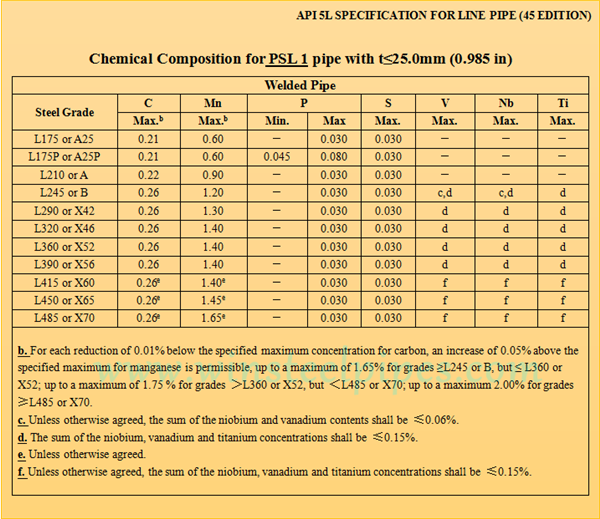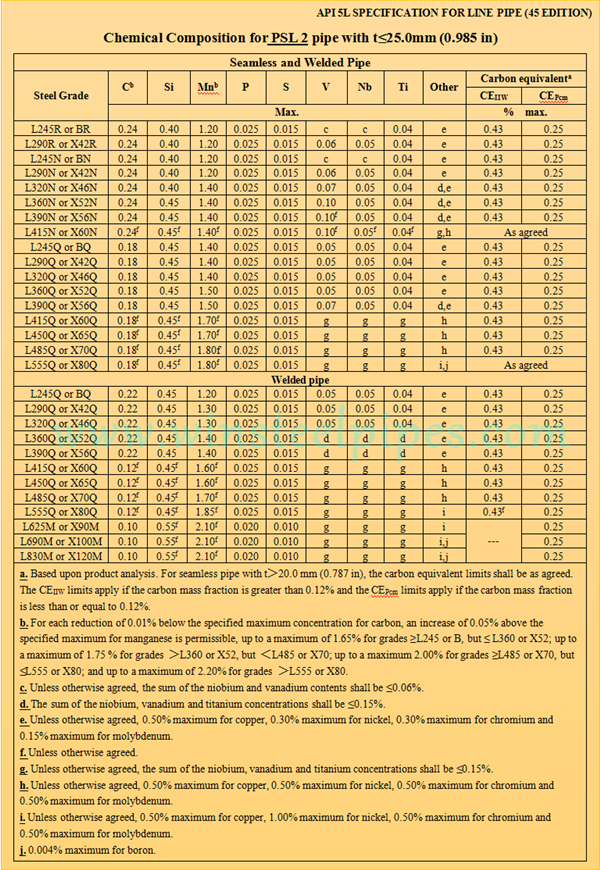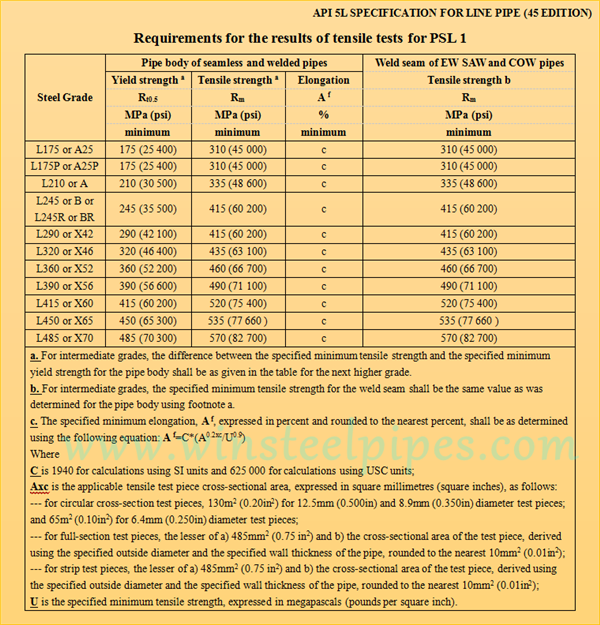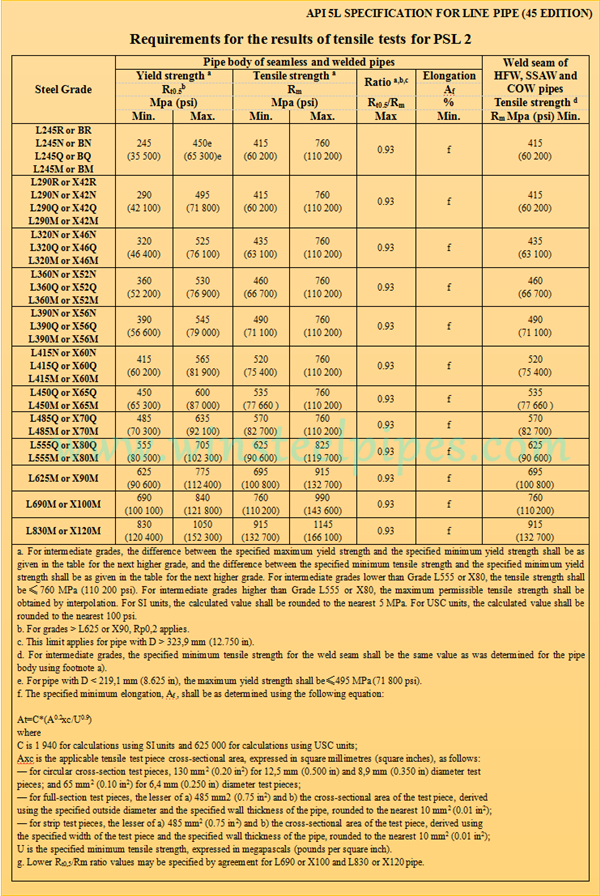What Are the difference between API 5L PSL 1 and PSL 2 pipes? When we distinguish API 5L PSL 1 and PSL 2, we learn it from this 5 aspects.
- Chemical Properties;
- Mechanical Properties;
- Manufacturing;
- Inspections and defect repair;
- Certification & tractability.
First, what is PSL stands for?
An API 5L line pipes manufactured in two varieties PSL 1 and PSL 2. But what is PSL stands for? PSL is short for Product Specification Levels. Pipes used in different types of environment such as corrosive and non-corrosive.
If pipes used in the severe corrosive environment. It required material withstand such process condition. If pipe used in a high-pressure condition required weld seam withstand such requires. On other hands for normal services, a standard quality level pipe will meet the purpose. That’s why there are two product levels. We can choose according to the condition which pipe used and cheapcal.
Second, from which aspects?
In API 5L specification, what are the main differences between API 5L PSL 1 & PSL 2? We compare them in these 5 aspects.
1. The difference between API 5L PSL1 and PSL2 Pipes – Chemical Properties
The difference between API 5L PSL1 and PSL2 pipes are as follows:
- ① Different steel grade.
- ② Three elements change when requirements change from API 5L PSL1 and PSL2.

The first element is Carbon. For example,for welded PSL1 pipe Max. Carbon is 0.26% for the grade B & higher. For all grades of PSL2 welded pipes max. carbon is 0.22%.
The second element is Phosphorus. For PSL1 pipe, largest Phosphorus is 0.03% for the grade A & higher. For all grades of PSL2 pipes, largest Phosphorus is 0.025%. So, the only difference is a grade lower than A.

The third element is Sulphur. For PSL1 pipe, largest Sulphur is 0.03%. For PSL2 pipes largest Sulphur is 0.015%.
2. The difference between API 5L PSL1 and PSL2 Pipes – Mechanical Properties

For PSL2 pipe, there is a limit on Largest Yield & Ultimate Tensile Strength. Whereas for PSL1 pipe meeting the least requirements are enough. The second rule is mandatory for PSL2 pipe is Fracture toughness which is not required for the PSL1 pipe.

3. The difference between API 5L PSL1 and PSL2 Pipes – Manufacturing
① Grade Range
For PSL 1, steel grade range from A25 to X70; For PSL 2 steel grade range from Grade B to X120.
But for LSAW of our company, PSL 2 range from Grade B to X80.
② Size range
For PSL 1 its size range from 0.405″ to 80″. For PSL 2 its size range from 4.5″ to 80″.
But for LSAW pipe, its ranges from 16″ to 60″.
③ Type of pipe ends
For PSL1 pipes are available in different types of ends. Such as Plain end, Threaded end, Bevelled end, special coupling pipes. For PSL2 pipes are available in only Plain End. (if no other agreements.) Want to learn more about LSAW pipe end please see the article “LSAW Steel Pipe End”
④ Welding method
All kinds of welding method are acceptable to manufacture PSL1. but, continuous welding limited to Grade A25. All other welding methods are acceptable For PSL2 welded pipes. Except continuous welding and laser welding.
And for electric weld welder frequency for PSL2 pipe. Its smallest 100kHz whereas there is no such limitation on the PLS1 pipe. Heat treatment of electric welds required for all Grades of PSL2 pipes whereas for PSL1 pipe. It requires for grades higher than X42.
4. Inspection and Defect Repair
Non-destructive inspection of seamless pipe is mandatory for PSL2 pipe. Whereas for PLS1 pipe it is supplementary requirements. Repair of pipe body plate and skim by welding is not allowed in PSL2 pipes whereas it allowed in PSL1 pipes. Weld repair without filler metal is not allowed in PSL2 pipes. Whereas it allowed with purchaser’s permission in PSL1 pipes.
5. Certification & Traceability
For PSL1 pipes, traceability & Certification is not required beyond the point when it passes all the required test. Whereas for PSL2 pipes, Traceability & Certification is mandatory.
In short, PSL1 pipes are standard quality pipe for normal services. And PSL2 pipes are higher quality pipe than PSL1. PSL 1 is a loose standard quality for line pipe. Whereas PSL 2 contains extra testing requirements. Such as stricter chemical physicals, along with different ceiling limits of mechanical properties. And it requires Charpy impact testing conditions.
From these 5 aspects we can distinguish API 5L PSL1 and PSL2. This tells the exact requirements for API 5L standard pipe.
API 5L specification is suitable for transporting gas, water, and oil. And it is usually found in the hydrocarbon petroleum and natural gas industry. Winsteel Group is a professional LSAW steel pipe manufacturer. We have API 5L certificate. And if you want to learn more about us, please see this.